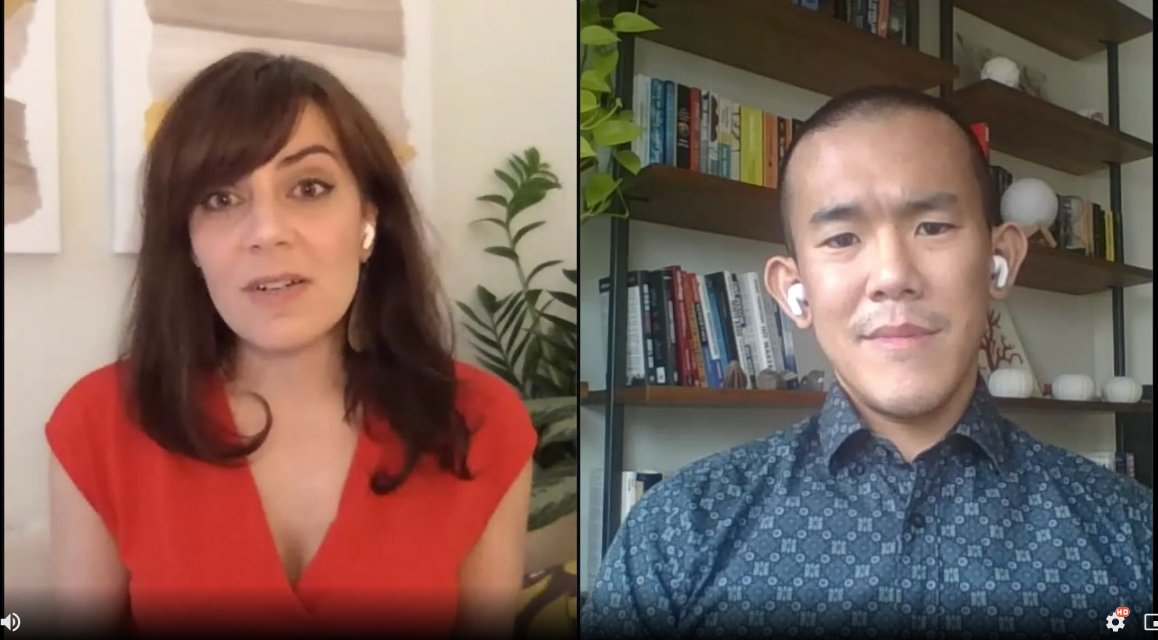Watching a conversation between @LizNeeley & @edyong209 (two of my favorite #scicomm-ers and humans), who are discussing how we should talk and make sense of #COVID19
1st point @edyong209 makes: #COVID19 more than a science story. It impacts EVERYTHING we do, EVERY aspect of society. Both he & @LizNeeley think about this when covering/talking about pandemic. As my friend @edmyayala says, making sense of these times requires pandemic mentality.
Of course @edyong209 just made me look bad for calling him a #scicomm-er  https://abs.twimg.com/emoji/v2/... draggable="false" alt="😂" title="Face with tears of joy" aria-label="Emoji: Face with tears of joy"> He takes opportunity to point out key role of journalism: give a nuanced look at the good and the bad of science. What journalism isn& #39;t: science cheerleading.
https://abs.twimg.com/emoji/v2/... draggable="false" alt="😂" title="Face with tears of joy" aria-label="Emoji: Face with tears of joy"> He takes opportunity to point out key role of journalism: give a nuanced look at the good and the bad of science. What journalism isn& #39;t: science cheerleading.
. @edyong209 discusses how accelerated pace of science during pandemic has amplified the erratic, complex and iterative nature of the process of science.
. @LizNeeley talks about how accelerated pace of science + uncertainty makes it harder for people to make sense of fire hose of information we are seeing during pandemic. Especially, since a lot of people may have a hard time making sense of process of science.
. @edyong209 talks about how misinformation spreads 6X faster online in context of covering a recent pre-print that went "viral". His approach was not only to correct misinfo but provide readers framework to use moving fwd to critically read other stories. https://www.theatlantic.com/health/archive/2020/05/coronavirus-strains-transmissible/611239/">https://www.theatlantic.com/health/ar...
. @LizNeeley brings up mental models — shortcuts we use to make sense of the world and how #scicomm-ers should be aware of these when attempting to correct misinformation. Understanding people have these mental models is a key aspect of understanding our audience.
. @edyong209 on correcting misinformation: hard to push on it when it is tied to peoples identities/values/beliefs. @LizNeeley provided some fantastic advice here  https://abs.twimg.com/emoji/v2/... draggable="false" alt="👉🏽" title="Right pointing backhand index (medium skin tone)" aria-label="Emoji: Right pointing backhand index (medium skin tone)"> https://www.theatlantic.com/ideas/archive/2020/03/how-talk-about-coronavirus/609118/">https://www.theatlantic.com/ideas/arc...
https://abs.twimg.com/emoji/v2/... draggable="false" alt="👉🏽" title="Right pointing backhand index (medium skin tone)" aria-label="Emoji: Right pointing backhand index (medium skin tone)"> https://www.theatlantic.com/ideas/archive/2020/03/how-talk-about-coronavirus/609118/">https://www.theatlantic.com/ideas/arc...
. @LizNeeley says it& #39;s not enough to say something is not true, but you should fill-in the knowledge gap people have.
@edyong209: countering misinformation is hard, often can be done in smaller settings where as a messenger you can leverage empathy and trust with other person(s)
@edyong209: countering misinformation is hard, often can be done in smaller settings where as a messenger you can leverage empathy and trust with other person(s)
. @LizNeeley offers a KEY pro-tip: DO NOT repeat misinformation. It can lead to familiarity bias (i.e., if you see something often you are more likely to believe it is true).
. @LizNeeley talks about the importance of *responding* and not just reacting when we see someone repeating or sharing misinformation.
. @LizNeeley & @edyong209 talk about our ability to act as nodes of information e.g., scientists are being pulled to do #COVID19 #scicomm even if that& #39;s not our expertise. We can be a source of trusted and correct information for your friends.
I, for example, am a neuroscientist but have been doing a lot of #COVID19 #scicomm in Spanish because I know I am a trusted source for Puerto Ricans & Spanish-speakers (and also a #scicomm expert).
However, as a neuroscientist, I recognize limitations of my knowledge and that I am not always the right messenger. As a communicator, I leverage my media relations and role with @CienciaPR to create space for others to communicate.

 Read on Twitter
Read on Twitter


